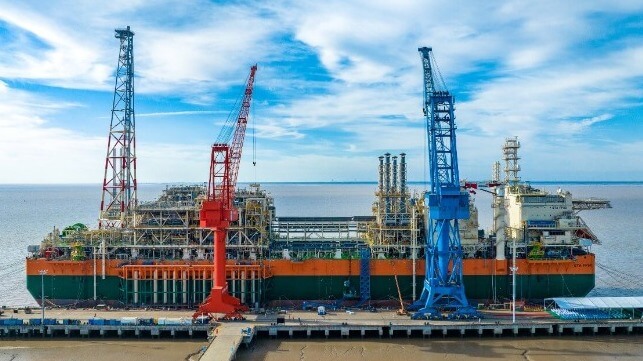Brand New FPSO Torn From its Moorings by Typhoon

Just one week after China Cosco Shipping Heavy Industry finished construction on BP's new Tortue FPSO, Typhoon Muifa slammed into the Yangtze River estuary and tore the new floating facility free from its moorings.
FIeld development partner Kosmos Energy reported that the FPSO for the Greater Tortue Ahmeyim project came away from the dock at the Cosco Qidong yard when its mooring lines "became compromised." It drifted some 200 meters away from the quay, and as of Sept. 16, work was under way to "enable the vessel to return to the quayside."
No injuries or pollution were reported, and the cost of the salvage and any potential damage will likely be covered by the project's insurers, Kosmos reported.
The Cosco Qidong Offshore Co. is located on the Changjiang River estuary, about 20 miles north of Shanghai. Typhoon Muifa made landfall in China in the Zhoushan archipelago on Wednesday night, packing winds of nearly 100 miles an hour. It then headed for Shanghai, making a second landfall in the early hours of Thursday morning before churning on to the northwest. It was the most powerful typhoon in modern history to reach the city.
Greater Tortue is a promising offshore gas basin off Mauritania and Senegal. The BP / Kosmos lease area covers five blocks and some 24,000 square kilometers of seabed. Exploratory drilling suggests that the Tortue field has about 15 trillion cubic feet (TCF) of gas reserves, and the basin as a whole could contain as much as 100 tcf.
The unique development plan calls for subsea gas wells connected to an FPSO located about 80 km closer to shore. The FPSO - the floating facility affected by the storm at Cosco Qidong - will remove heavier fractions from the gas flow and pump the remaining gas another 35 km to a floating liquefaction plant, which will be permanently moored at a pier near shore. The FLNG plant is being built as a conversion using the hull of an existing LNG carrier. The partners had hoped to see first gas produced from the project by the third quarter of 2023.
Technip FMC won the contract to design, procure and install the FPSO in 2019 for a total price of up to $1 billion, and Cosco Shipping Heavy Industry secured the contract to build the vessel and its topside modules. The work was delayed by the COVID-19 pandemic, and Cosco finally held the completion ceremony on September 9 - one week before the storm.
